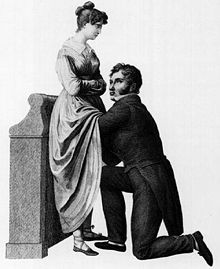Modesty in medical settings refers to the practices and equipment used to preserve patient modesty in medical examination and clinics.

Tools for modesty
editPrior to the invention of the stethoscope, a physician who wanted to perform auscultation to listen to heart sounds or noise inside a body would have to physically place their ear against the body of the person being examined.[1] In 1816, male physician René Laennec invented the stethoscope as a way to respect the modesty of a female patient, as it would have been awkward for him to put his ear on her chest.[1]
Hospital gowns increase modesty as compared to the patient presenting nude, but in the past have been odd clothing which exposes the body.[2] Some contemporary changes to the design of hospital gowns are proposed.[2]
Society and culture
editIn places with more cultural diversity it becomes more likely that people will make new and different requests for modesty in health care.[3]
Special populations
editSometimes women do not access healthcare because of modesty concerns.[4]
Muslims in non-Muslim societies sometimes make requests for modesty.[5][6]
References
edit- ^ a b Ariel Roguin (September 2006). "Rene Theophile Hyacinthe Laennec (1781-1826): the man behind the stethoscope". Clinical Medicine & Research. 4 (3): 230–235. doi:10.3121/cmr.4.3.230. PMC 1570491. PMID 17048358.
- ^ a b Luthra, Shefali (4 April 2015). "Hospital Gowns Get a Makeover — The Atlantic". theatlantic.com. Retrieved 13 April 2015.
- ^ Seibert, PS; Stridh-Igo, P; Zimmerman, CG (June 2002). "A checklist to facilitate cultural awareness and sensitivity". Journal of Medical Ethics. 28 (3): 143–6. doi:10.1136/jme.28.3.143. PMC 1733575. PMID 12042396.
- ^ Schoueri-Mychasiw, N; Campbell, S; Mai, V (February 2013). "Increasing screening mammography among immigrant and minority women in Canada: a review of past interventions". Journal of Immigrant and Minority Health. 15 (1): 149–58. doi:10.1007/s10903-012-9612-8. PMID 22466249. S2CID 6780923.
- ^ Rassool, GH (April 2015). "Cultural competence in nursing Muslim patients". Nursing Times. 111 (14): 12–5. PMID 26182584.
- ^ Boucher, NA; Siddiqui, EA; Koenig, HG (2017). "Supporting Muslim Patients During Advanced Illness". The Permanente Journal. 21: 16–190. doi:10.7812/TPP/16-190. PMC 5469433. PMID 28609264.
External links
edit- patientmodesty.org/, a United States-based nonprofit organization advocating for modesty